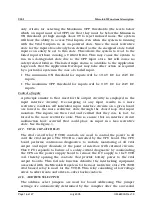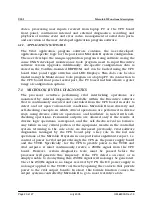
USSI Microlok II Functional description
Page 6 of 27 July 2005 UM-6800A Rev1.3
4.1.1. ENVIRONMENTAL
•
The Microlok II product will operate in a standard railway environment
•
The system operates in ambient temperature ranges of –40 to +70 degrees
centigrade. This refers to the temperature outside the card file but inside
the relevant building enclosure
•
The system operates from 0 to 95% non-condensing humidity
•
The system meets the required EMI specification
•
The system meets the required vibration specification
4.1.2. PHYSICAL
•
The card file is 16.75” wide and it can be mounted in a standard 19” rack
•
Boards in the card file include a faceplate where status information will be
displayed. A blank panel will be available to cover empty slots
•
The system will accept power from an external battery in the range of 9.8V
DC to 16.2V DC for an internal conversion to the required voltages
•
The internal power converter will have a start-up voltage requirement of
11.5V DC to inhibit start-up when the battery voltage is low
•
Nominal 24V input/output boards will have an input/output supply in
the range of 19.6V DC to 32.4V DC
4.1.3. CARDFILE
The Microlok II card file is a G64/96 bus based card file that holds the CPU,
Power Supply & Variety of I/O boards. The card file will be a user
configurable. The Microlok II card file is designed to house standard 6UX220
Euro card plug-in printed circuit boards. The card file will have twenty slots.
•
Slots No. 1 to 15 & 20 are used to accommodate Non-Vital or Vital I/O
boards.
•
Slot No. 16 & 17 are reserved for Power Supply board.
•
Slot No. 18 & 19 are reserved for CPU board.
4.1.4. CPU BOARD
The CPU board is controlled by a Motorola 68332 microprocessor, which
operates at a speed of 21 MHz, and includes 2K bytes of internal fast
termination RAM. Most internal operations are 32 bits wide, while all outside
bus cycles are 16 or 8 bits wide. The executive and application software is
stored in four flash EPROMs that provide up to 8MB of memory. Flash
EPROMs permit direct handling of the executive and application software
using a PC connected to the CPU board front panel serial port connector.
Jumpers are provided on the board to enable or disable the flash EPROMs for









































